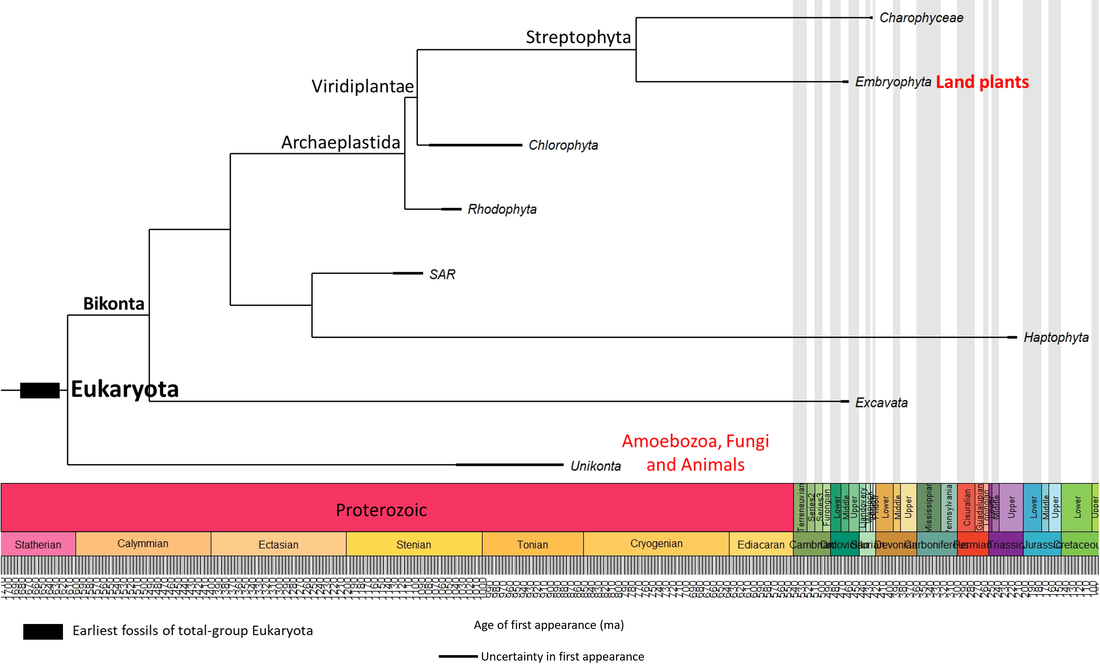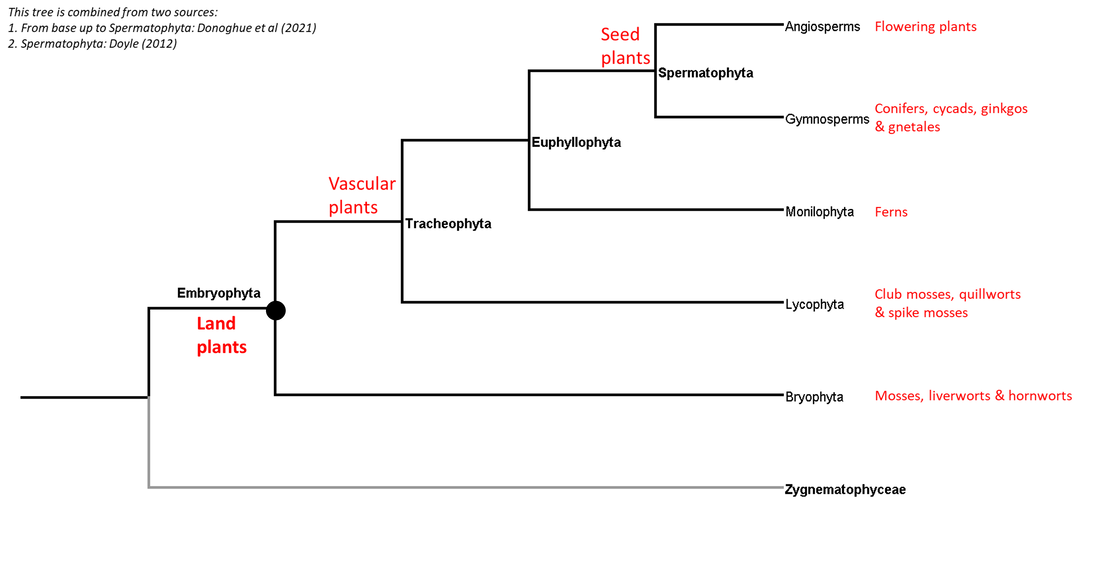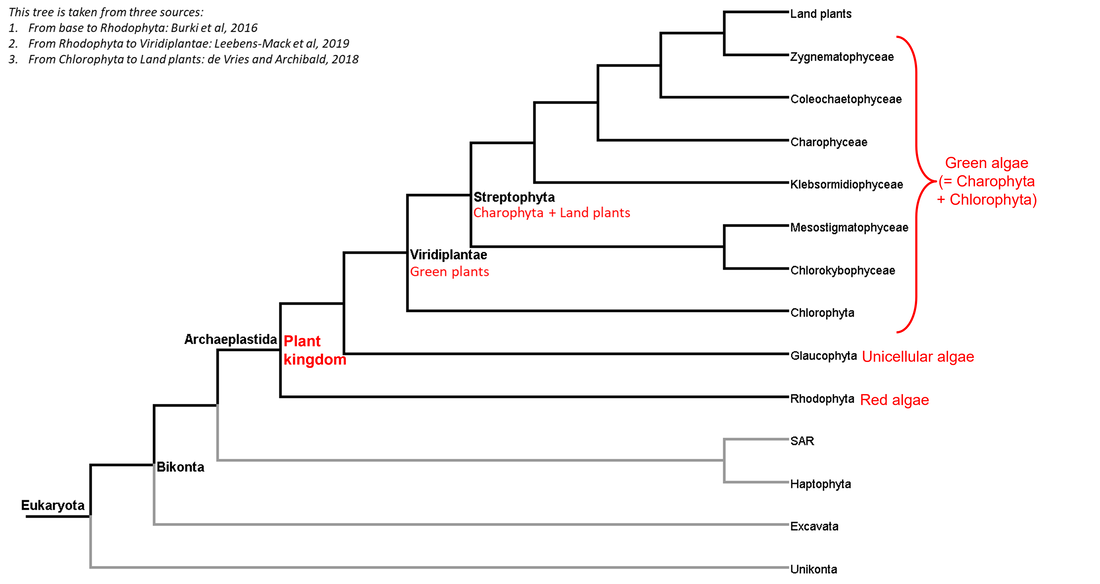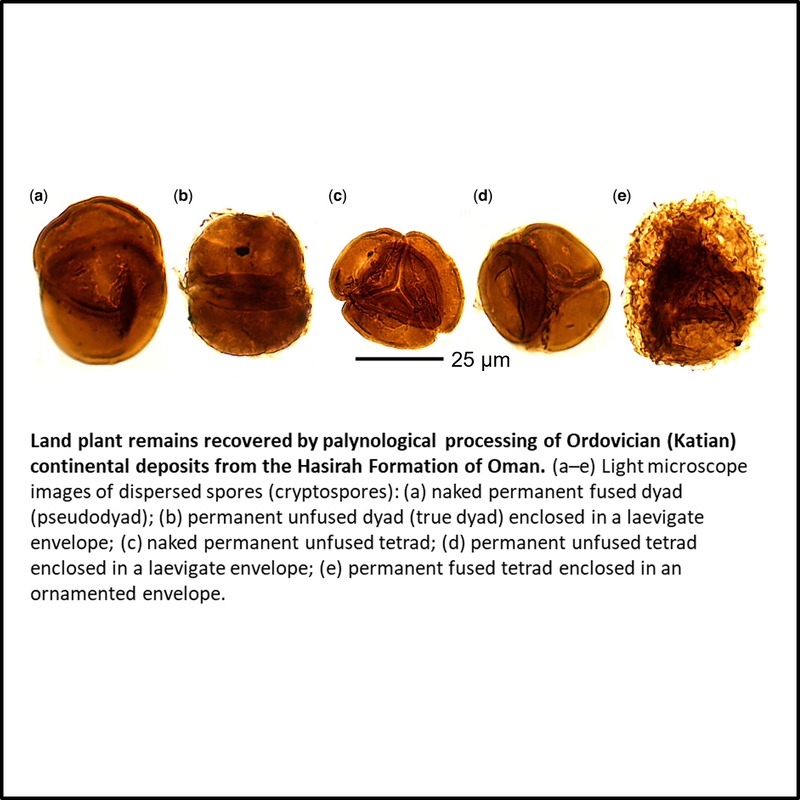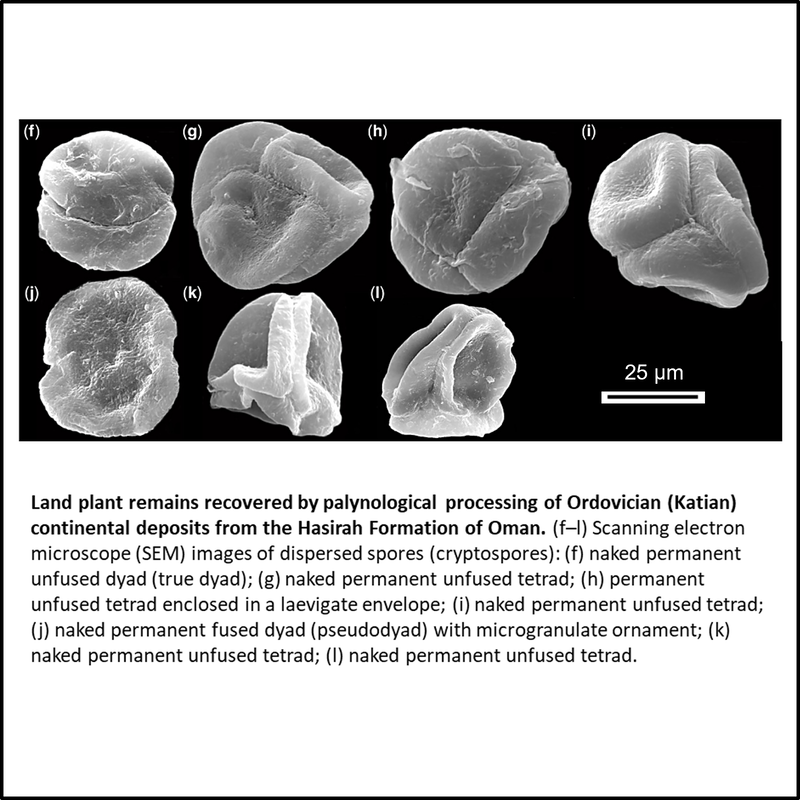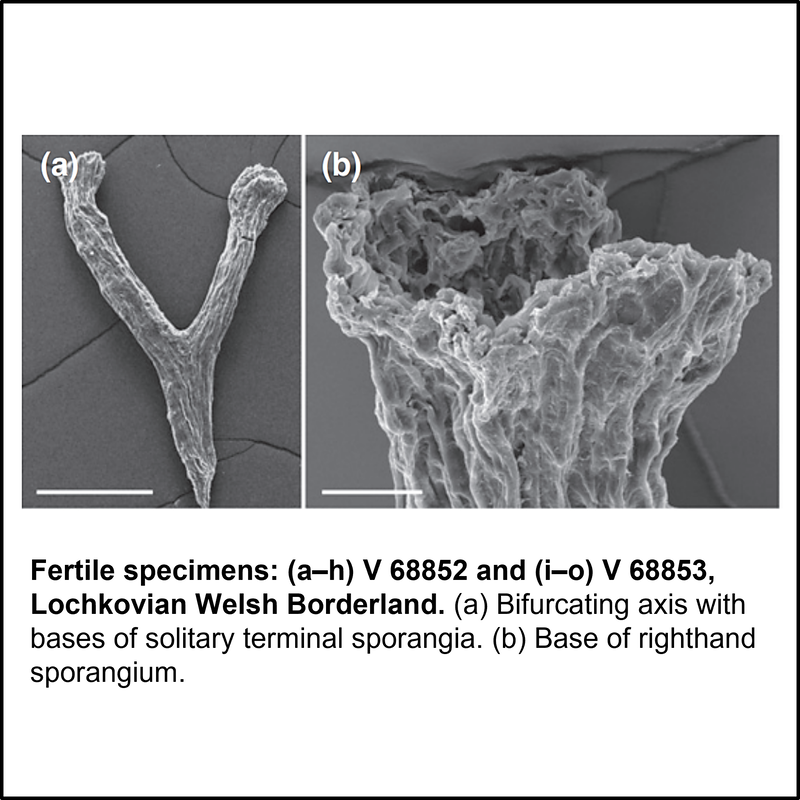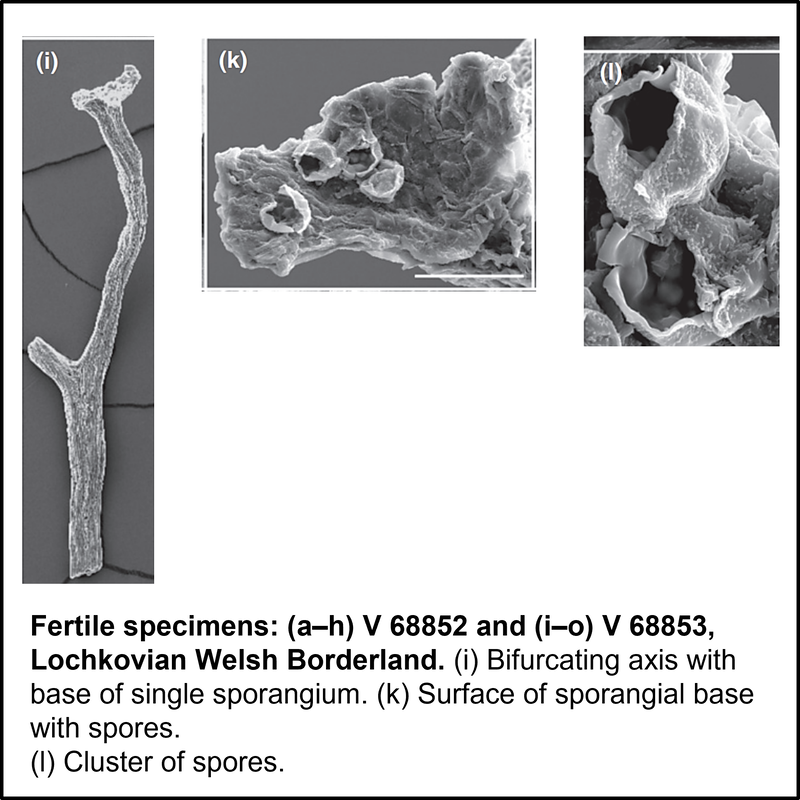The land plants (superphylum Embryophyta within the infrakingdom Streptophyta) represent one of the two groups to be considered in this website, the other being the animals. The phylogenetic context of the land plants is illustrated in the following time tree:
Figure 1. Phylogenetic time tree showing first appearance of total-group clades within the Bikonta (excluding clades with no fossil record)
The above tree illustrates the large amount of time (at least 1.1 billion years) that elapsed between the appearance of the eukaryotes and that of the land plants.
A summary phylogenetic tree of the land plants is shown below:
A summary phylogenetic tree of the land plants is shown below:
Figure 2. Summarized phylogenetic tree of the land plants
The crown node of the land plants is shown as a black dot.
After reviewing the origin of the land plants in terms of their ancestors between the appearance of the crown eukaryotes and that of the crown-Embryophyta, this section of the website will examine the fossil evidence for the evolution of each of the terminal clades shown in the above figure.
For plant fossils, an important issue of nomenclature needs to be understood clearly. Fossils of plant materials often do not represent entire plants, but rather separate organs, such as leaves, stems, roots, cones or flowers. In many cases, it can be difficult to assign these organs to a known whole-plant species. The common practice has been to assign such fossils to what is known as a "form genus" (Faegri, 1963). These are commonly assigned to a whole-plant taxon at a later date, when more fossil data become available. A useful discussion of the use of form taxa and the related organ taxa can be found in Bateman and Hilton (2009). The plant fossils shown in this website are whole-plant taxa unless otherwise stated.
After reviewing the origin of the land plants in terms of their ancestors between the appearance of the crown eukaryotes and that of the crown-Embryophyta, this section of the website will examine the fossil evidence for the evolution of each of the terminal clades shown in the above figure.
For plant fossils, an important issue of nomenclature needs to be understood clearly. Fossils of plant materials often do not represent entire plants, but rather separate organs, such as leaves, stems, roots, cones or flowers. In many cases, it can be difficult to assign these organs to a known whole-plant species. The common practice has been to assign such fossils to what is known as a "form genus" (Faegri, 1963). These are commonly assigned to a whole-plant taxon at a later date, when more fossil data become available. A useful discussion of the use of form taxa and the related organ taxa can be found in Bateman and Hilton (2009). The plant fossils shown in this website are whole-plant taxa unless otherwise stated.
Origin of the land plants
The origin of the land plants may be traced by examining the phylogenetic relationships along the line of descent that connects the land plants with the division of the eukaryotes into the bikonts and the unikonts, as shown below:
Figure 3. Summarized phylogenetic tree of the Bikonta
The above tree reflects the generally accepted view that land plants evolved from the green algae (Wodniok et al, 2011). The oldest unequivocal evidence for the divergence of the embryophyte lineage from the green algae is provided by cryptospores (Donoghue at al, 2021), which are defined as non-marine sporomorphs, with no visible haptotypic features such as contact areas or tetrad marks. Single grains or monads, “permanent” dyads (and the separated products of dyads) and tetrads are included (Edwards et al, 2014, citing the original definitions of Richardson et al, 1984 and Richardson, 1988). These features, together with the depositional context of non-marine environments, allow cryptospores to be distinguished from acritarchs, which are of mainly marine origin (Shan et al, 2022). Cryptospores are also differentiated from trilete spores, which are largely considered to represent vascular plants and their immediate ancestors (Rubinstein and Vajda, 2019).
Some examples of cryptospores are illustrated below (click on image for larger view):
Some examples of cryptospores are illustrated below (click on image for larger view):
Figure 4. Examples of cryptospores
Cryptospores are generally found as isolated fossils, but recent work on Upper Silurian to Lower Devonian rocks in the Welsh Borderland has identified tiny land plants with sporangia that contain cryptospores (Edwards et al, 2022). The latter authors have classified these plants as eophytes (Subclass Eophytidae in Class Embryopsida). Some examples are illustrated below (for larger view, click on image):
Figure 5. Examples of eophytes
The oldest known cryptospores are of Middle Ordovician age (Wellman et al, 2023). One particular species, Tetrahedraletes cf. medinensis, has been proposed as the oldest known member of the crown-Embryophyta (Morris et al, 2018; Harris et al, 2022), but its first appearance, in the Dapingian stage of the Middle Ordovician of Argentina (Rubinsten et al, 2010) has been challenged by Strother et al (2015) on the basis of its questionable identification. If we discount this occurrence, the earliest known appearance of cryptospores is a little later, in the Darriwilian stage of the Middle Ordovician (Edwards et al, 2015; Vecoli et al, 2017).
Given that only Tetrahedraletes cf. medinensis has been proposed as a crown-group land plant, and has only been identified with confidence in Late Ordovician and younger rocks (Gray et al, 1985; Cocks and Fortey, 1986), it seems advisable to apply to these Middle Ordovician cryptospores the opinion of Donoghue et al (2021) that it is not clear whether cryptopores represent stem- or crown-group land plants. We therefore assign these oldest cryptospores only to the total-group Embryophyta.
Given that only Tetrahedraletes cf. medinensis has been proposed as a crown-group land plant, and has only been identified with confidence in Late Ordovician and younger rocks (Gray et al, 1985; Cocks and Fortey, 1986), it seems advisable to apply to these Middle Ordovician cryptospores the opinion of Donoghue et al (2021) that it is not clear whether cryptopores represent stem- or crown-group land plants. We therefore assign these oldest cryptospores only to the total-group Embryophyta.
References
Bateman, R. M., & Hilton, J. (2009). Palaeobotanical systematics for the phylogenetic age: applying organ species, form species and phylogenetic species concepts in a framework of reconstructed fossil and extant whole plants. Taxon, 58(4), 1254-1280.
Burki, F., Kaplan, M., Tikhonenkov, D. V., Zlatogursky, V., Minh, B. Q., Radaykina, L. V., ... & Keeling, P. J. (2016). Untangling the early diversification of eukaryotes: a phylogenomic study of the evolutionary origins of Centrohelida, Haptophyta and Cryptista. Proceedings of the Royal Society B: Biological Sciences, 283(1823), 20152802.
Butterfield, N. J. (2000). Bangiomorpha pubescens n. gen., n. sp.: implications for the evolution of sex, multicellularity, and the Mesoproterozoic/Neoproterozoic radiation of eukaryotes. Paleobiology , 26( 3), 386-404.
de Vries, J., & Archibald, J. M. (2018). Plant evolution: landmarks on the path to terrestrial life. New Phytologist, 217(4), 1428-1434.
Donoghue, P. C., Harrison, C. J., Paps, J., & Schneider, H. (2021). The evolutionary emergence of land plants. Current Biology, 31(19), R1281-R1298.
Doyle, J. A. (2012). Molecular and fossil evidence on the origin of angiosperms. Annual review of earth and planetary sciences, 40, 301-326.
Edwards, D., Morris, J. L., Richardson, J. B., & Kenrick, P. (2014). Cryptospores and cryptophytes reveal hidden diversity in early land floras. New Phytologist, 202(1), 50-78.
Edwards, D., Cherns, L., & Raven, J. A. (2015). Could land‐based early photosynthesizing ecosystems have bioengineered the planet in mid‐Palaeozoic times?. Palaeontology, 58(5), 803-837.
Edwards, D., Morris, J. L., Axe, L., Duckett, J. G., Pressel, S., & Kenrick, P. (2022). Piecing together the eophytes–a new group of ancient plants containing cryptospores. New Phytologist, 233(3), 1440-1455.
Faegri, K. (1963). Organ and form genera: significance and nomenclatural treatment. Taxon, 12 (1), 20-28.
Harris, B. J., Clark, J. W., Schrempf, D., Szöllősi, G. J., Donoghue, P. C., Hetherington, A. M., & Williams, T. A. (2022). Divergent evolutionary trajectories of bryophytes and tracheophytes from a complex common ancestor of land plants. Nature Ecology & Evolution, 6(11), 1634-1643.
Leebens-Mack, J.H., Barker, M.S., Carpenter, E.J. et al. (2019). One thousand plant transcriptomes and the phylogenomics of green plants. Nature 574, 679–685. https://doi.org/10.1038/s41586-019-1693-2.
Morris, J. L., Puttick, M. N., Clark, J. W., Edwards, D., Kenrick, P., Pressel, S., ... & Donoghue, P. C. (2018). The timescale of early land plant evolution. Proceedings of the National Academy of Sciences, 115(10), E2274-E2283.
Richardson, J. B. (1988). Late Ordovician and Early Silurian cryptospores and miospores from northeast Libya. In: El-Arnauti A, Owens B, Thusu B, eds. Subsurface palynostratigraphy of northeast Libya. Benghazi, Libya: Garyounis University Publications, 89–110.
Richardson, J. B., Ford, J. H., & Parker, F. (1984). Miospores, correlation and age of some Scottish Lower Old Red Sandstone sediments from the Strathmore region (Fife and Angus). Journal of Micropalaeontology, 3(2), 25.
Rubinstein, C. V., & Vajda, V. (2019). Baltica cradle of early land plants? Oldest record of trilete spores and diverse cryptospore assemblages; evidence from Ordovician successions of Sweden. GFF, 141(3), 181-190.
Rubinstein, C. V., Gerrienne, P., de la Puente, G. S., Astini, R. A., & Steemans, P. (2010). Early Middle Ordovician evidence for land plants in Argentina (eastern Gondwana). New Phytologist, 188(2), 365-369.
Shan, L., Yan, K., Zhang, Y., Li, J., & Servais, T. (2022). Palaeoecology of Cambrian–Ordovician acritarchs from China: evidence for a progressive invasion of the marine habitats. Philosophical Transactions of the Royal Society B, 377(1847), 20210035.
Strother, P. K., Traverse, A., & Vecoli, M. (2015). Cryptospores from the Hanadir Shale member of the Qasim formation, Ordovician (Darriwilian) of Saudi Arabia: taxonomy and systematics. Review of Palaeobotany and Palynology, 212, 97-110.
Tang, Q., Pang, K., Yuan, X., & Xiao, S. (2020). A one-billion-year-old multicellular chlorophyte. Nature Ecology & Evolution, 1-7.
Vecoli, M., Wellman, C. H., Gerrienne, P., Le Hérissé, A., & Steemans, P. (2017). Middle Ordovician cryptospores from the Saq-Hanadir transitional beds in the QSIM-801 well, Saudi Arabia. Revue de micropaléontologie, 60(3), 319-331.
Wellman, C. H., Cascales-Miñana, B., & Servais, T. (2023). Terrestrialization in the Ordovician. Geological Society, London, Special Publications, 532(1), SP532-2022.
Wodniok, S., Brinkmann, H., Glöckner, G., Heidel, A. J., Philippe, H., Melkonian, M., & Becker, B. (2011). Origin of land plants: do conjugating green algae hold the key?. BMC Evolutionary Biology, 11(1), 104.
Burki, F., Kaplan, M., Tikhonenkov, D. V., Zlatogursky, V., Minh, B. Q., Radaykina, L. V., ... & Keeling, P. J. (2016). Untangling the early diversification of eukaryotes: a phylogenomic study of the evolutionary origins of Centrohelida, Haptophyta and Cryptista. Proceedings of the Royal Society B: Biological Sciences, 283(1823), 20152802.
Butterfield, N. J. (2000). Bangiomorpha pubescens n. gen., n. sp.: implications for the evolution of sex, multicellularity, and the Mesoproterozoic/Neoproterozoic radiation of eukaryotes. Paleobiology , 26( 3), 386-404.
de Vries, J., & Archibald, J. M. (2018). Plant evolution: landmarks on the path to terrestrial life. New Phytologist, 217(4), 1428-1434.
Donoghue, P. C., Harrison, C. J., Paps, J., & Schneider, H. (2021). The evolutionary emergence of land plants. Current Biology, 31(19), R1281-R1298.
Doyle, J. A. (2012). Molecular and fossil evidence on the origin of angiosperms. Annual review of earth and planetary sciences, 40, 301-326.
Edwards, D., Morris, J. L., Richardson, J. B., & Kenrick, P. (2014). Cryptospores and cryptophytes reveal hidden diversity in early land floras. New Phytologist, 202(1), 50-78.
Edwards, D., Cherns, L., & Raven, J. A. (2015). Could land‐based early photosynthesizing ecosystems have bioengineered the planet in mid‐Palaeozoic times?. Palaeontology, 58(5), 803-837.
Edwards, D., Morris, J. L., Axe, L., Duckett, J. G., Pressel, S., & Kenrick, P. (2022). Piecing together the eophytes–a new group of ancient plants containing cryptospores. New Phytologist, 233(3), 1440-1455.
Faegri, K. (1963). Organ and form genera: significance and nomenclatural treatment. Taxon, 12 (1), 20-28.
Harris, B. J., Clark, J. W., Schrempf, D., Szöllősi, G. J., Donoghue, P. C., Hetherington, A. M., & Williams, T. A. (2022). Divergent evolutionary trajectories of bryophytes and tracheophytes from a complex common ancestor of land plants. Nature Ecology & Evolution, 6(11), 1634-1643.
Leebens-Mack, J.H., Barker, M.S., Carpenter, E.J. et al. (2019). One thousand plant transcriptomes and the phylogenomics of green plants. Nature 574, 679–685. https://doi.org/10.1038/s41586-019-1693-2.
Morris, J. L., Puttick, M. N., Clark, J. W., Edwards, D., Kenrick, P., Pressel, S., ... & Donoghue, P. C. (2018). The timescale of early land plant evolution. Proceedings of the National Academy of Sciences, 115(10), E2274-E2283.
Richardson, J. B. (1988). Late Ordovician and Early Silurian cryptospores and miospores from northeast Libya. In: El-Arnauti A, Owens B, Thusu B, eds. Subsurface palynostratigraphy of northeast Libya. Benghazi, Libya: Garyounis University Publications, 89–110.
Richardson, J. B., Ford, J. H., & Parker, F. (1984). Miospores, correlation and age of some Scottish Lower Old Red Sandstone sediments from the Strathmore region (Fife and Angus). Journal of Micropalaeontology, 3(2), 25.
Rubinstein, C. V., & Vajda, V. (2019). Baltica cradle of early land plants? Oldest record of trilete spores and diverse cryptospore assemblages; evidence from Ordovician successions of Sweden. GFF, 141(3), 181-190.
Rubinstein, C. V., Gerrienne, P., de la Puente, G. S., Astini, R. A., & Steemans, P. (2010). Early Middle Ordovician evidence for land plants in Argentina (eastern Gondwana). New Phytologist, 188(2), 365-369.
Shan, L., Yan, K., Zhang, Y., Li, J., & Servais, T. (2022). Palaeoecology of Cambrian–Ordovician acritarchs from China: evidence for a progressive invasion of the marine habitats. Philosophical Transactions of the Royal Society B, 377(1847), 20210035.
Strother, P. K., Traverse, A., & Vecoli, M. (2015). Cryptospores from the Hanadir Shale member of the Qasim formation, Ordovician (Darriwilian) of Saudi Arabia: taxonomy and systematics. Review of Palaeobotany and Palynology, 212, 97-110.
Tang, Q., Pang, K., Yuan, X., & Xiao, S. (2020). A one-billion-year-old multicellular chlorophyte. Nature Ecology & Evolution, 1-7.
Vecoli, M., Wellman, C. H., Gerrienne, P., Le Hérissé, A., & Steemans, P. (2017). Middle Ordovician cryptospores from the Saq-Hanadir transitional beds in the QSIM-801 well, Saudi Arabia. Revue de micropaléontologie, 60(3), 319-331.
Wellman, C. H., Cascales-Miñana, B., & Servais, T. (2023). Terrestrialization in the Ordovician. Geological Society, London, Special Publications, 532(1), SP532-2022.
Wodniok, S., Brinkmann, H., Glöckner, G., Heidel, A. J., Philippe, H., Melkonian, M., & Becker, B. (2011). Origin of land plants: do conjugating green algae hold the key?. BMC Evolutionary Biology, 11(1), 104.
Image credits - Land Plants
- Header: Sunset in the woods in Tok, Alaska, United States. By Diego Delso [CC BY-SA 4.0 (https://creativecommons.org/licenses/by-sa/4.0)]
- Figure 4: From Open Access article Wellman, C. H., Cascales-Miñana, B., & Servais, T. (2023). Terrestrialization in the Ordovician. Geological Society, London, Special Publications, 532(1), SP532-2022.
- Figure 5: From Open Access article Edwards, D., Morris, J. L., Axe, L., Duckett, J. G., Pressel, S., & Kenrick, P. (2022). Piecing together the eophytes–a new group of ancient plants containing cryptospores. New Phytologist, 233(3), 1440-1455.
